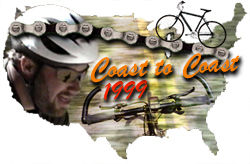
 Prologue
Prologue
Day 1 - 8
Day 9 -17
Day 18 -26
Day 27 - 33
Day 34 - 40
Day 41 - 48
Day 49 - 56
Day 57 - 64
Day 65 - 72
Day 74 - 78
Epilogue
Bicycle Touring: Is it for you? Part I
by Fred MeredithMix a spirit of adventure with the simplicity of a bicycle and touring will happen. Sometimes it's the desire to get away from a sedentary lifestyle, sometimes it's the dread of another overcrowded vacation destination, but for those with some form of mid-life crisis or wanderlust, the resurgent interest exists for "going out long" on a bicycle. It even captures the imagination of non-cyclists, drawing them into the world of the two-wheeled traveler/adventurer.
With increasing awareness of health issues and the environment, a generation of empty-nest "boomers" is finding that bicycle touring builds a sense of accomplishment and self-worth, produces a more up-close and thought-provoking view of the world, and strengthens the cardiovascular system. When compared with the usual auto road-trip, it also conserves the world's natural resources and reduces the number of pollutants released into the environment.
So, what should you do when the urge strikes? How should you deal with it? Should you plunk down your life savings on the latest ultimate escape vehicle and set out for Katmandu?
Well, probably not. There are different kinds of touring and each has its own attraction and particular needs. A little research wouldn't hurt.
Tours of the "offered" variety (they plan/you pay) come as one-day tours, weekend tours, and longer "vacation" tours. They can be domestic or foreign and the route may be a closed-loop (begin and end at the same location) or point-to-point (with bus, plane or train return travel). Do-it-yourself touring routes, on the other hand, can be planned as well, but offer the additional adventure of occasionally (or frequently) unfamiliar roads of whimsy.
Basically, touring is traveling by bicycle, and questions of "how far" or "for how long" are limited only by imagination and resources. But, for someone who has never toured, where is a good place to begin?
Probably the easiest jumping on point is a recreational bicycle club. Most clubs offer rides on the weekends, at no charge, with distances of 20 to 50 or more miles. These are like mini-tours. Add at least one outing during the week and conditioning will happen. In no time the urge will strike to do a "century" ride.
Century Rides: The One Day Tour.
While Tour de France isn't touring (it's racing), the Tour de Possum, Tour de Fireant, Tour de well lots of bike rides that begin with "Tour," are all actually one-day fundraising events century rides designed to raise money for a cause. One day does not a tour make, but if the ride is well supported it can be a good gauge of your physical readiness for touring.
Century rides usually offer several distances in addition to the 100-mile route. Pick the one that isn't too easy or too out of reach for you.
Just about any good-fitting road bike will do for a fully-supported (sometimes called 'sagged' folklore indicates that "sag" stands for Support And Gear) century ride. Some hardy souls even ride mountain bikes, though the upright riding position, fat tires and greater weight of these bikes result in up to four times the effort to cover the same distance, and usually a much slower pace.
But, if a mountain bike or hybrid is your steed of choice (or by default), don't despair. Think of it as better training for future rides. Just be careful about which distance you select, knowing that you're doing up to four times the work of a road biker on the same route.
Tool and accessory needs are minimal on century rides. Ride sponsors ask only that participants repair their own flat tires (always carry one or two inner tubes, tire tools, frame pump and maybe a patch kit). Roving support vehicles are usually equipped to assist with more complicated malfunctions. Sag vehicles will generally stop any time they encounter a cyclist with a problem and they have been known to fix flats for the more helpless looking (and cuter) riders.
About everything you will need during one of these rides will fit in jersey pockets, a fanny pack or an under-saddle bag. That usually includes sunscreen, emergency calories (energy bar) and some cash in case of an unexpected store stop. Cameras are optional, depending on how often you like to stop and take pictures. Don't put your camera where you will sweat on it or bang it if your bike falls over. Two water bottles or a CamelBak should provide enough fluids to cover the 10 to 15 miles between rest stops. Drink a lot. "Hydrate or Die," is more than just a slogan.
Building up to the 100-mile or even the 100-kilometer (62.5 -mile) distance should be the budding tourist's first goal. Any cyclist who can ride 60 miles in an eight-hour day and get on the bike for another 60 miles the next day, is ready for multi-day touring.



